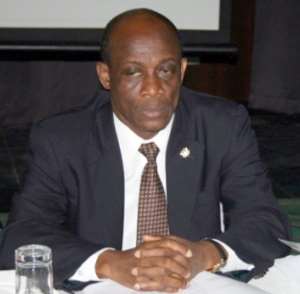
The country’s economic growth, Gross Domestic Product (GDP) for 2015 has been calculated to have grown by 3.9 percent in 2015.
This is marginally lower compared to the 4.0 percent growth recorded in 2014.
According to the provisional GDP figures released by the Ghana Statistical Service last week, the decline was influenced by a slowdown in the agricultural sector from 4.6 percent in 2014 to 2.4 percent in 2015.
This was as a result of a reduction in cocoa production for last year.
Despite this challenge, other sectors, like services witnessed a significant growth with almost 6 percent growth.
The GDP estimates also shows that the services sectors currently commands that biggest share of the economy, accounting for about almost 50 percent, followed by agriculture with 28 percent and Industry.
However, when the energy crises was at its peak economic growth went up by almost 5 percent, compared to the 4.5 percent in the same quarter for 2014.
Meanwhile Deputy Government Statistician, Baah Wadie, says things could have been better if the energy crises had not set in.
Figures from the Ghana Statistical Service show that Ghana’s economy is currently worth 139 billion Ghana cedis. If this figure is shared among the 27 million population, every Ghanaian will get 5,057 Ghana cedis ($1,339).
According to figures from the Ghana Statistical Service, the last time the economy recorded growth below 4 percent was in 2000 when GDP, which measures the value of final goods and services produced in the country, decelerated to 3.7 percent.
However, the latest GDP figures, are expected to serve as an encouragement to government of a rebound in economic activities, as Finance Minister Seth Terkper in June last year announced to Parliament that government had revised its expectation of economic growth for 2015 from 4.1 percent to 3.5 percent.
The Deputy Government Statistician, Baah Wadieh, at a press briefing in Accra last week said that the economy’s biggest growth period was recorded in the last three months of 2015, following improvement in the erratic energy supply challenges which forced businesses to cut production output.
He said the GDP figure for the fourth quarter was 4.9 percent, which is more than the 3.7, 3.3 and 3.6 percent recorded for the third, second and first quarters respectively.
The sector that performed highest in the fourth quarter was Industry, which recorded negative growths in the previous two quarters. The sector grew in the quarter by 7.2 percent, the highest for the sector in any quarter of a year since the second quarter of 2013. This was followed by the Services sector which recorded a growth rate of 5.2 percent in the fourth quarter, with the Agricultural sector trailing behind with a growth rate of 4 percent.
According to the Ghana Statistical Service, at current market prices the Ghanaian economy is now worth about GHc139.9 billion. However, when adjusted for inflation, the value of the economy is a little above GHc34.8 billion in constant terms from 2006.
Government is hopeful that this year economic activities will rebound with a projected real GDP growth of 5.4 percent -- despite the International Monetary Fund, which is helping in management of the economy under a three-year Extended Credit Facility programme, lowering Ghana’s economic growth in 2016 to 4.5 percent as a result of the continued fall in prices of commodities on the world market.
However, the country’s fiscal managers are confident improvements in energy supply will boost economic activities and cause businesses -- which performed at half their capacity or shut down completely at the peak of the energy crisis last year -- to ramp-up output.
According to managers of the economy, the economy would have recovered from the commodities price shock experienced last year and expanded faster than it did had the energy challenges been addressed earlier.
This is underscored by Mr. Wadieh, who opined that “but for the energy crisis, the industrial sector would have grown beyond the 7.2 percent”.
It is worthy to note that industry’s performance last year largely depended on the water and sewage sub-sector, which contributed 26.9 percent to the industrial sector with construction taking 6.2 percent, while oil and gas contributed the least with 0.3 percent.
Health and social work also contributed 18.2 percent to the Services sector; with public administration, defence and social security contributing 17.1 percent, while education and finance recorded 10.5 percent and 7.2 percent respectively; thereby taking the sectoral contribution to GDP to 49.6 percent.




 'Kill whoever will rig Ejisu by-election' – Independent Candidate supporters inv...
'Kill whoever will rig Ejisu by-election' – Independent Candidate supporters inv...
 Ashanti Region: ‘Apologize to me for claiming I owe electricity bills else... – ...
Ashanti Region: ‘Apologize to me for claiming I owe electricity bills else... – ...
 Ghana is a mess; citizens will stand for their party even if they’re dying — Kof...
Ghana is a mess; citizens will stand for their party even if they’re dying — Kof...
 Internet shutdown an abuse of human rights — CSOs to gov't
Internet shutdown an abuse of human rights — CSOs to gov't
 Free SHS policy: Eating Tom Brown in the morning, afternoon, evening will be a t...
Free SHS policy: Eating Tom Brown in the morning, afternoon, evening will be a t...
 Dumsor: A British energy expert 'lied' Ghanaians, causing us to abandon energy p...
Dumsor: A British energy expert 'lied' Ghanaians, causing us to abandon energy p...
 What a speech! — Imani Africa boss reacts to Prof. Opoku Agyemang’s presentation
What a speech! — Imani Africa boss reacts to Prof. Opoku Agyemang’s presentation
 Dumsor: Tell us the truth — Atik Mohammed to ECG
Dumsor: Tell us the truth — Atik Mohammed to ECG
 Dumsor: Don't rush to demand timetable; the problem may be temporary — Atik Moha...
Dumsor: Don't rush to demand timetable; the problem may be temporary — Atik Moha...
 Space X Starlink’s satellite broadband approved in Ghana — NCA
Space X Starlink’s satellite broadband approved in Ghana — NCA
